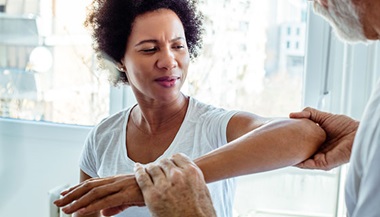Hip Labral Tear
Hip labral tears can happen to anyone, but most often affect athletes who participate in high-impact sports.
What You Need to Know
- A labral tear is an injury to the tissue that holds the ball and socket parts of the hip together.
- Torn hip labrum may cause pain, reduced range of motion in the hip and a sensation of the hip locking up.
- Labral tears are typically caused by overuse, traumatic injuries or abnormalities in the shape or alignment of the hip bones.
- Hip labral tears can be treated with or without surgery. If surgery is needed, it can be done with a minimally invasive approach.
What is a labral tear of the hip?
A labral tear of the hip is an injury to the labrum — a ring of cartilage on the socket part of the hip joint. Your hip joint is a ball-and-socket joint, composed of the ball, which is the top of your femur (femoral head) and a socket, which is part of your pelvis (acetabulum). The labrum helps keep the bones of the hip joint aligned and in place as you move. It also helps keep the joint fluid inside the joint to ensure frictionless motion.
The extent of hip labral tears can vary. Sometimes, hip labrum can have mini tears or fray at the edges. This usually happens due to a gradual wear on the labrum. In other cases, a section of hip labrum can separate, or tear away, from the socket bone. These types of hip labrum injuries are usually due to trauma.
Types of Hip Labral Tears
A hip labral tear can occur anywhere along the labrum. Doctors sometimes describe labral tears as anterior or posterior, depending on which part of the joint is affected:
- Anterior hip labral tears: The most common type of hip labral tear. These tears occur on the front of the hip joint.
- Posterior hip labral tears: These tears occur on the back of the hip joint.
Hip Labral Tear Symptoms
Hip labral tears cause similar symptoms regardless of the type of tear. But where you feel the symptoms may change depending on whether the tear is in the front or the back of the hip labrum.
Hip labral tear symptoms include:
- Pain in the hip, groin or buttocks, especially as you walk or run, and sometimes at night when you sleep.
- Hip stiffness or limited range of motion
- A clicking or locking sensation in the hip joint when you move
Some labral tears of the hip may cause no symptoms, and can go unnoticed for years.
Hip Labral Tear Causes
Hip labral tears can happen to anyone. Hip labrum can tear suddenly, as a result of an impact, or gradually. Causes typically include:
- Repetitive hip motions and hip overuse (especially in certain sports and occupations)
- Traumatic hip injuries
- Regular wear and tear of the hip
- Deformities of the hip joint, such as hip dysplasia and abnormal bone shape that leads to hip impingement, can increase stress on the labrum.
- Degenerative conditions such as osteoarthritis. The relationship between osteoarthritis and hip labral tears goes both ways: The erosion of cartilage caused by arthritis can contribute to a labral tear, and a labral tear can make you more likely to develop arthritis years later.
Causes of hip labral tears may vary depending on the location of the tear. Anterior hip labral tears are usually caused by repetitive movements common in sports such as ballet, golf, football or hockey. Posterior hip labral tears are usually caused by traumatic injuries such as falls, accidents or high-impact sports injuries.
How are hip labral tears diagnosed?
Your doctor may use the following diagnostic methods to determine if your symptoms are caused by a labral tear of the hip:
- Physical exam to assess signs of swelling and inflammation, your range of motion in the hip and movements that cause pain.
- X-ray to detect any abnormalities in the shape or alignment of the hip joint as wells as signs of arthritis.
- MRI scan with or without contrast material to get a better view of the soft tissues surrounding the hip joint, including hip labrum.
If the labral tear diagnosis is still unclear after these tests, your doctor may recommend an ultrasound-guided injection with a painkiller. If it relieves pain, then it is likely that the cause is a labral tear.
Can a hip labral tear heal on its own?
Hip labral tears do not heal on their own. However, if your tear is minor and is not causing much pain or limiting your mobility, it’s possible to manage the symptoms without repairing the tear.
Hip Labral Tear Treatment
There are several options to treat labral tears of the hip. Typically, your doctor will recommend nonsurgical treatments first, but depending on the severity of the tear and your pain, surgery may be the best approach.
Nonsurgical Treatments
Nonsurgical treatments for hip labral tears focus on managing the symptoms and preventing further damage to the labrum:
- Rest and activity modification aim to reduce or eliminate movements that cause pain and aggravate the injury.
- Over-the-counter medications such as ibuprofen can help manage pain and inflammation.
- Injections to the hip with steroids and anesthetics can help temporarily relieve pain and inflammation if over-the-counter medications don’t offer sufficient relief.
- Physical therapy involves exercises that can help strengthen and stretch your hip muscles so they can better support the joint and allow you to move with less pain.
Johns Hopkins Hip Preservation Clinic

Hip Labral Tear Surgery
If your hip labral tear is severe, or if you are still in pain after trying nonsurgical options, your doctor may recommend surgery. The most common surgery to repair hip labral tears is arthroscopic surgery. During this procedure, an orthopaedic surgeon makes several small incisions to access the hip. With the help of a special camera device called an arthroscope, the surgeon locates the labral tear and uses surgical tools to repair it.
Repairing a hip labral tear may involve removing frayed pieces of labrum, stitching the tear back together or using tissues from other parts of the body to replace a missing piece of labrum.
If your labral tear was caused by a hip impingement, the surgeon will address it by reshaping the bones of your hip joint so they glide smoothly.
Recovery After Hip Labrum Repair
Arthroscopic surgery is typically an outpatient procedure, which means you can go home the same day. After your hip labrum repair, you will be able to return to low-impact activities such as walking almost immediately. Your surgeon will refer you to a physical therapist to start exercising your hip to restore your range of motion and strengthen the joint.
If your job is in a low-activity environment, such as an office job, you may be able to return to work in one to two weeks after your hip labral tear surgery. If your job puts significant stress on the hip, you can work with your physical therapists to determine a safe return date or discuss job modifications with your employer to allow you to ease back into work as you recover.






